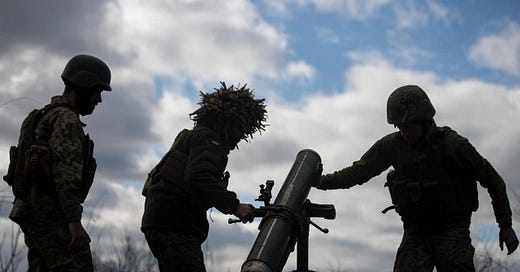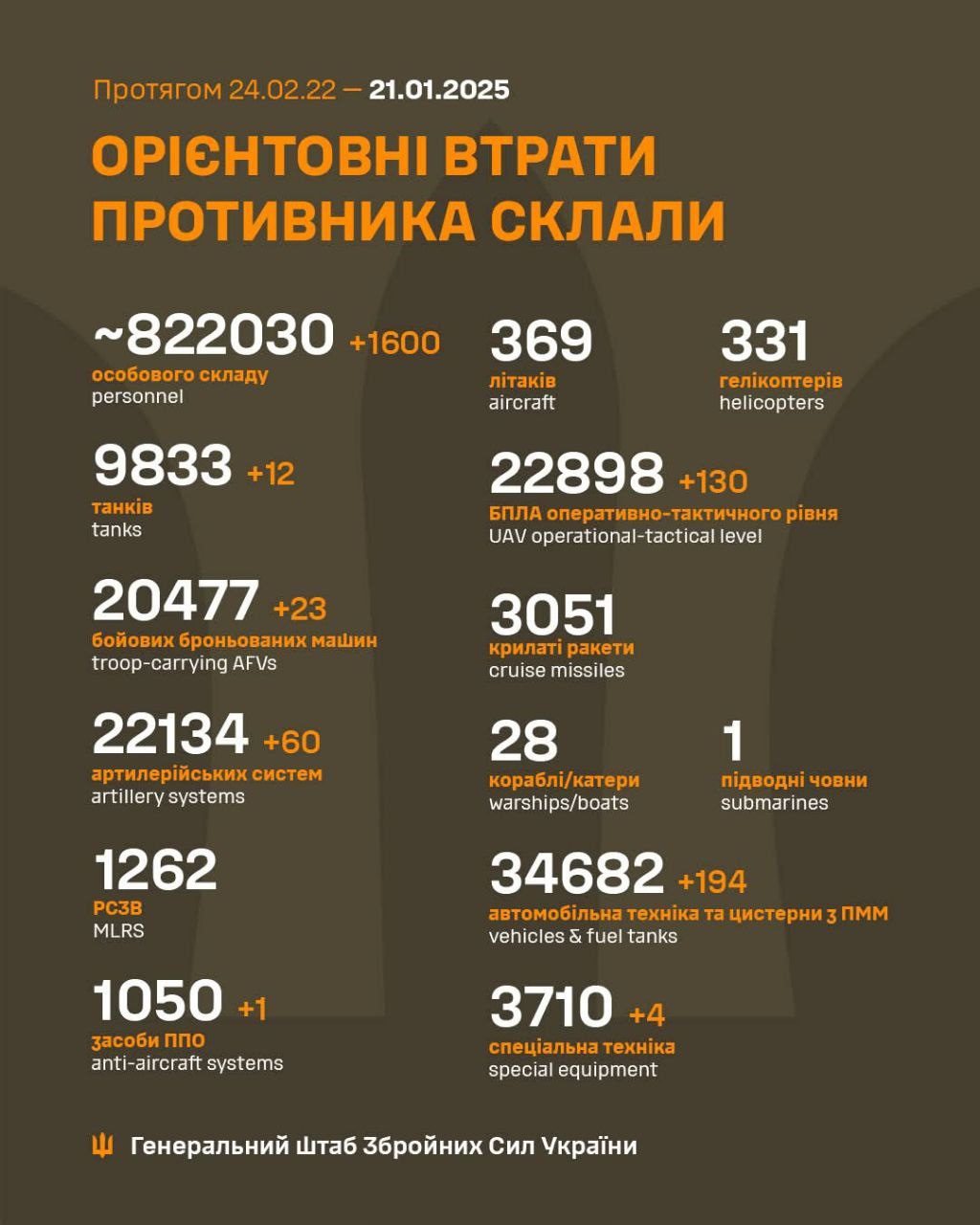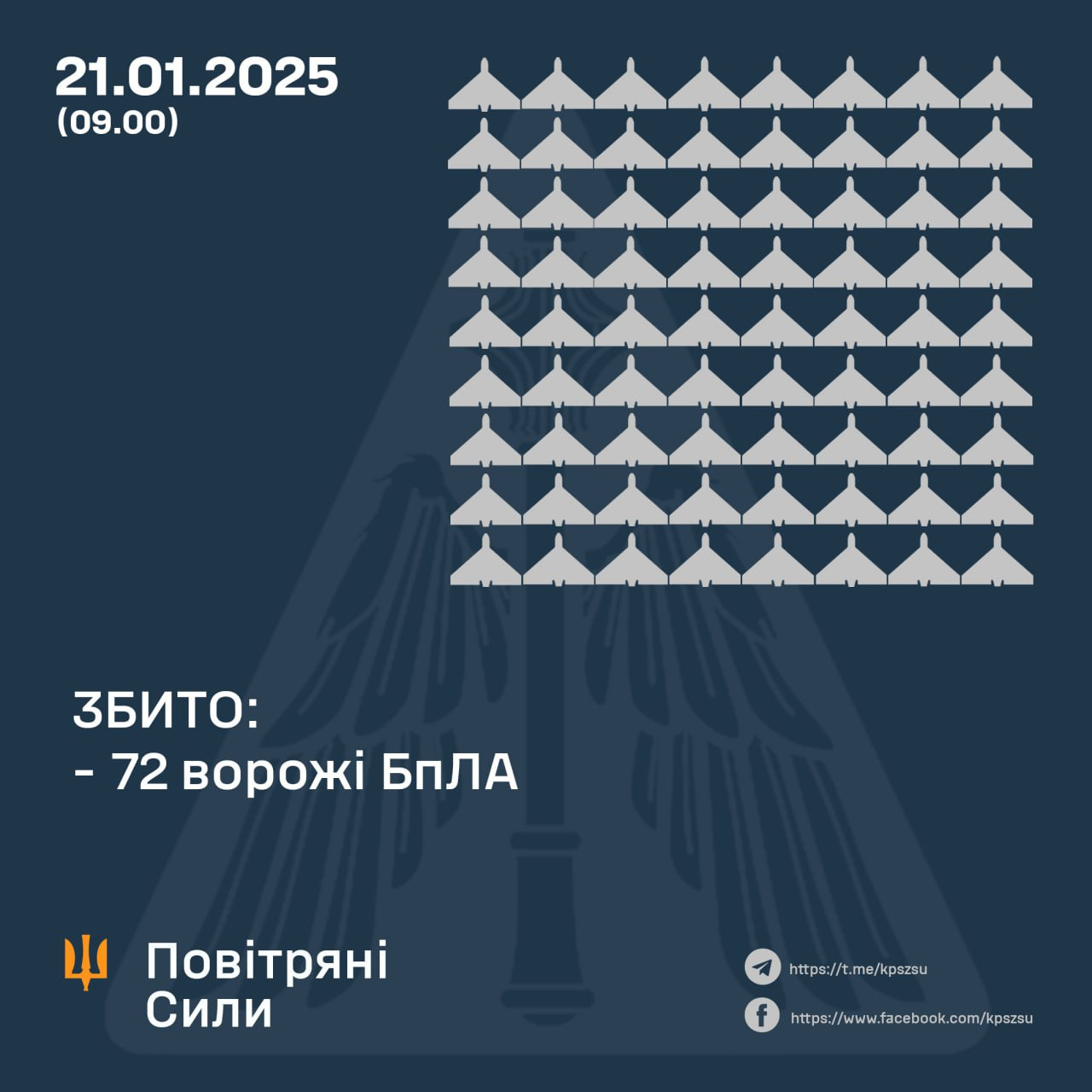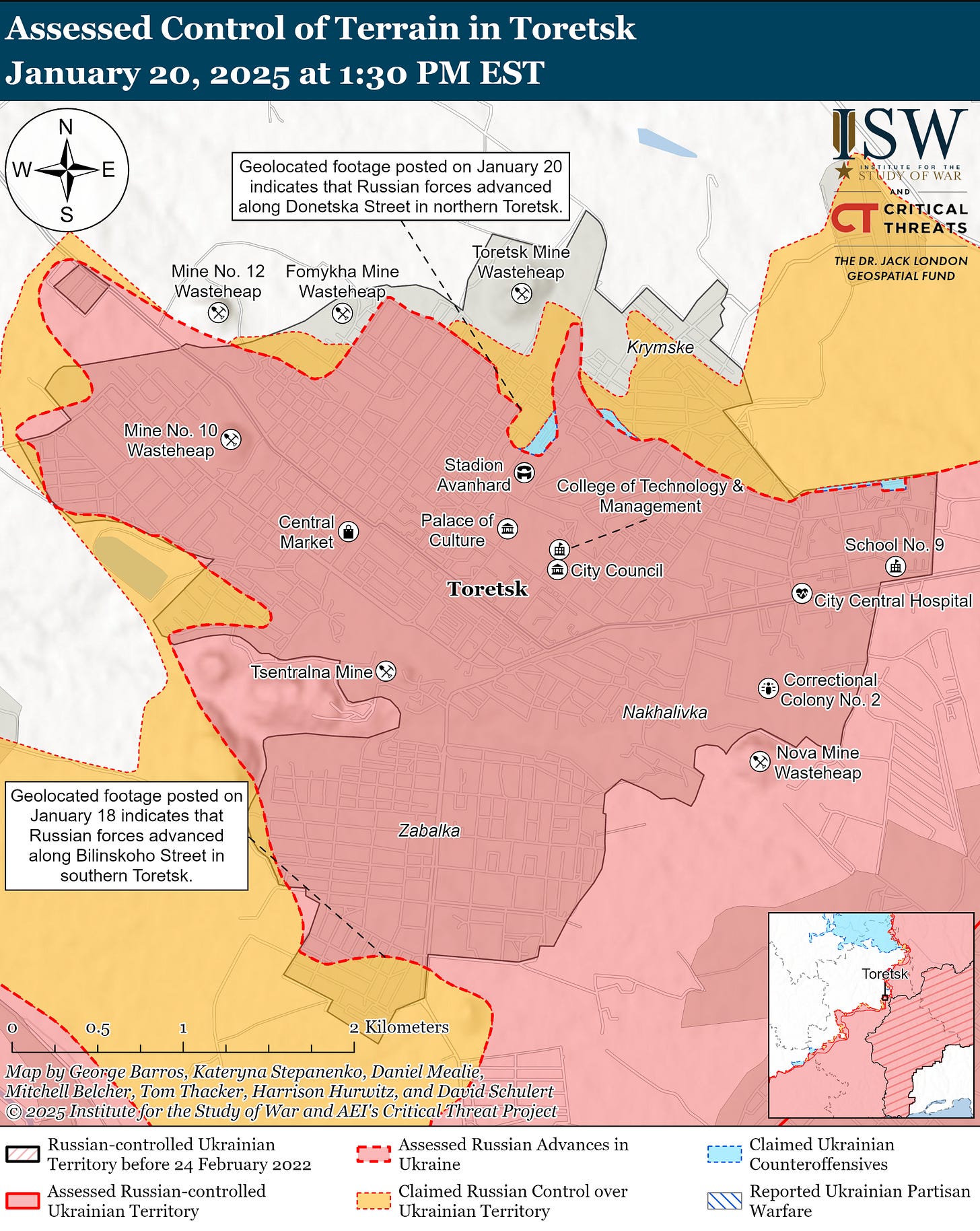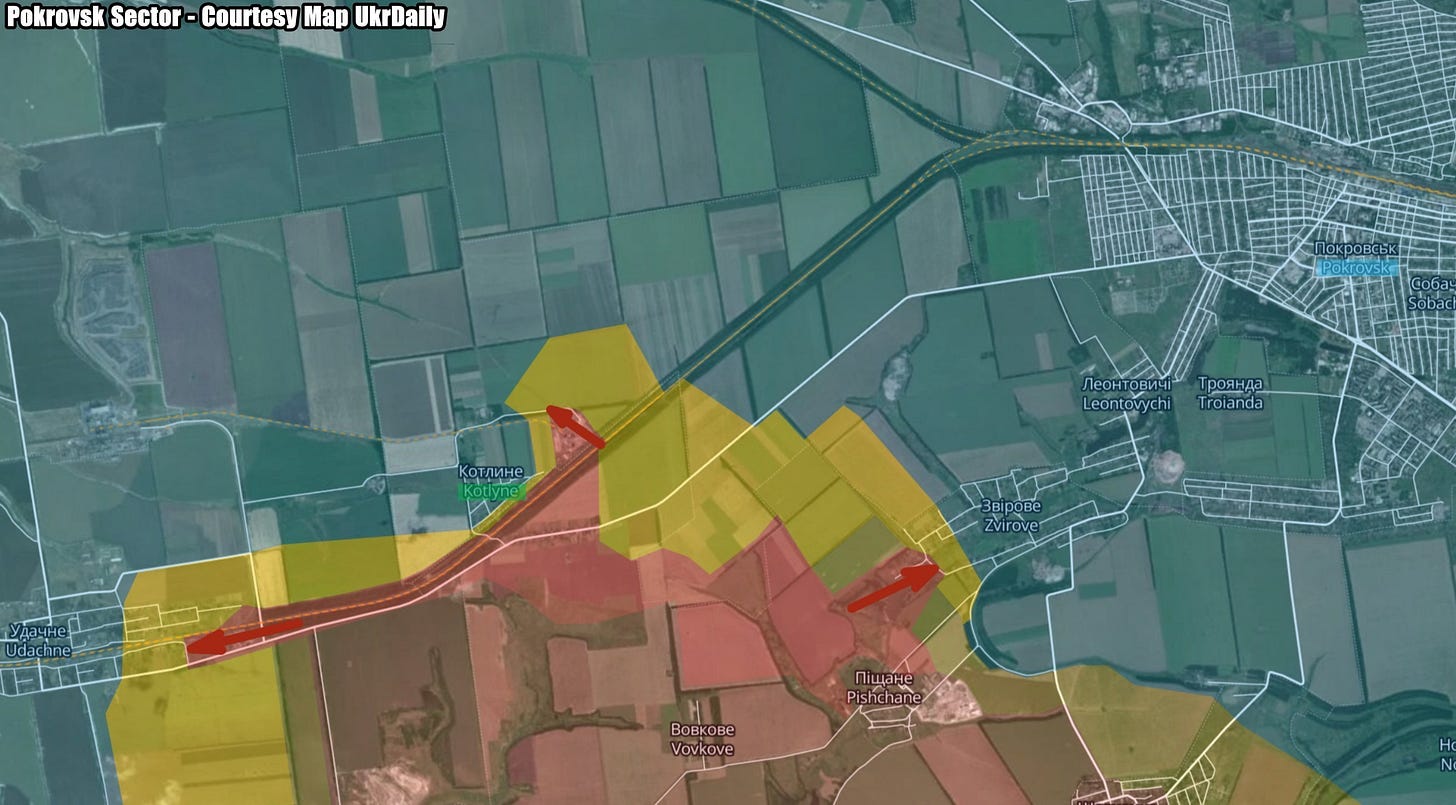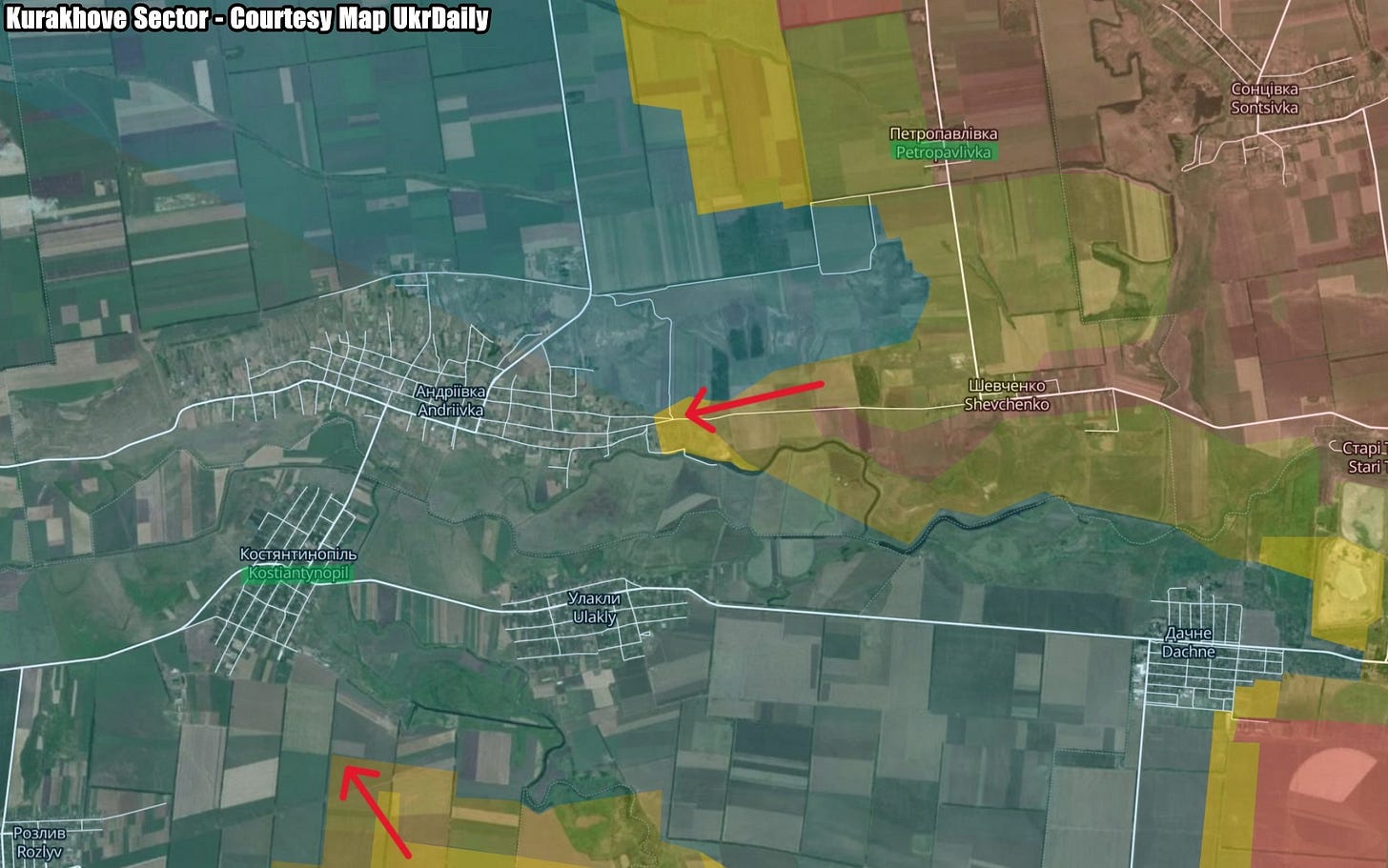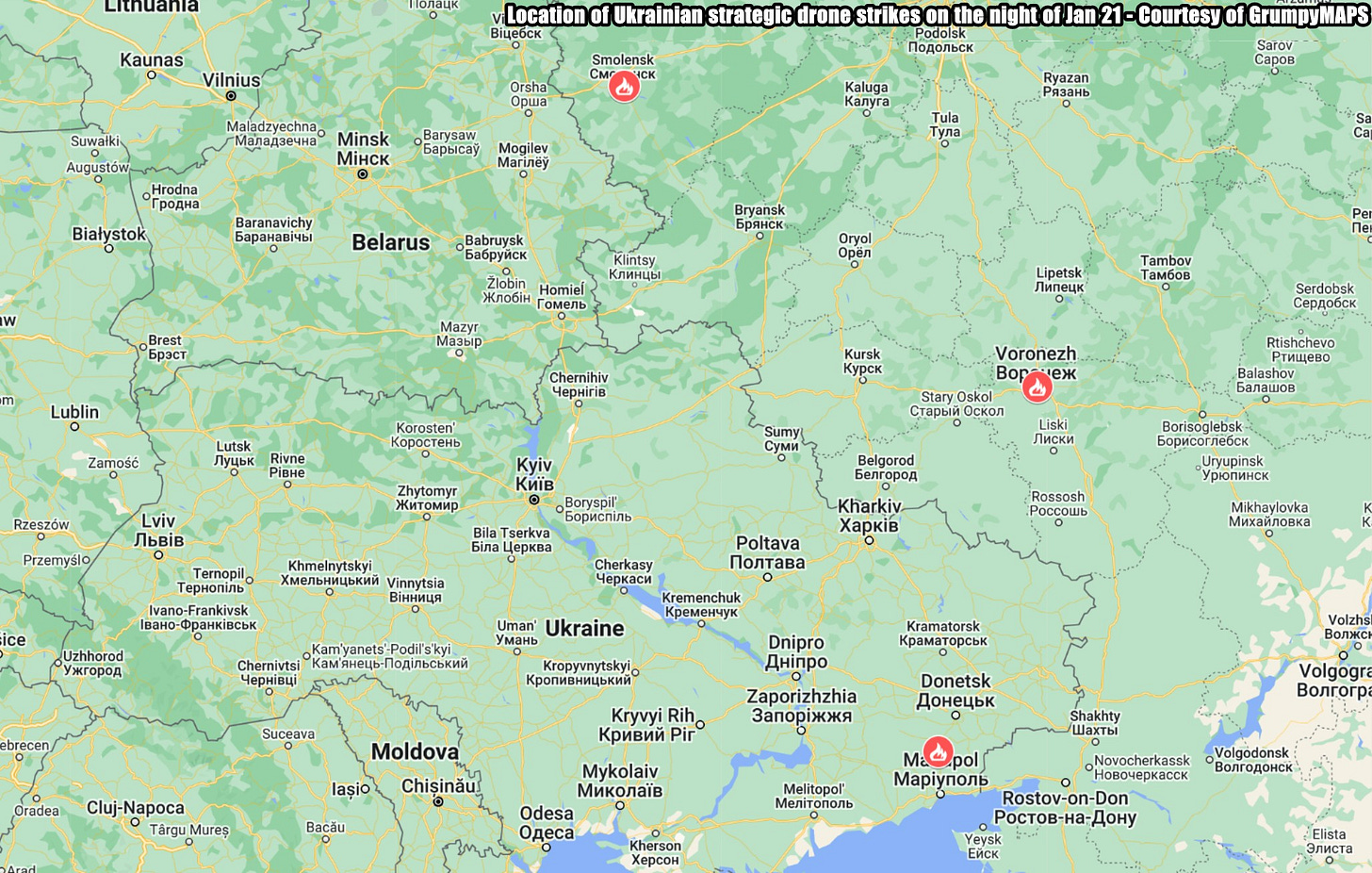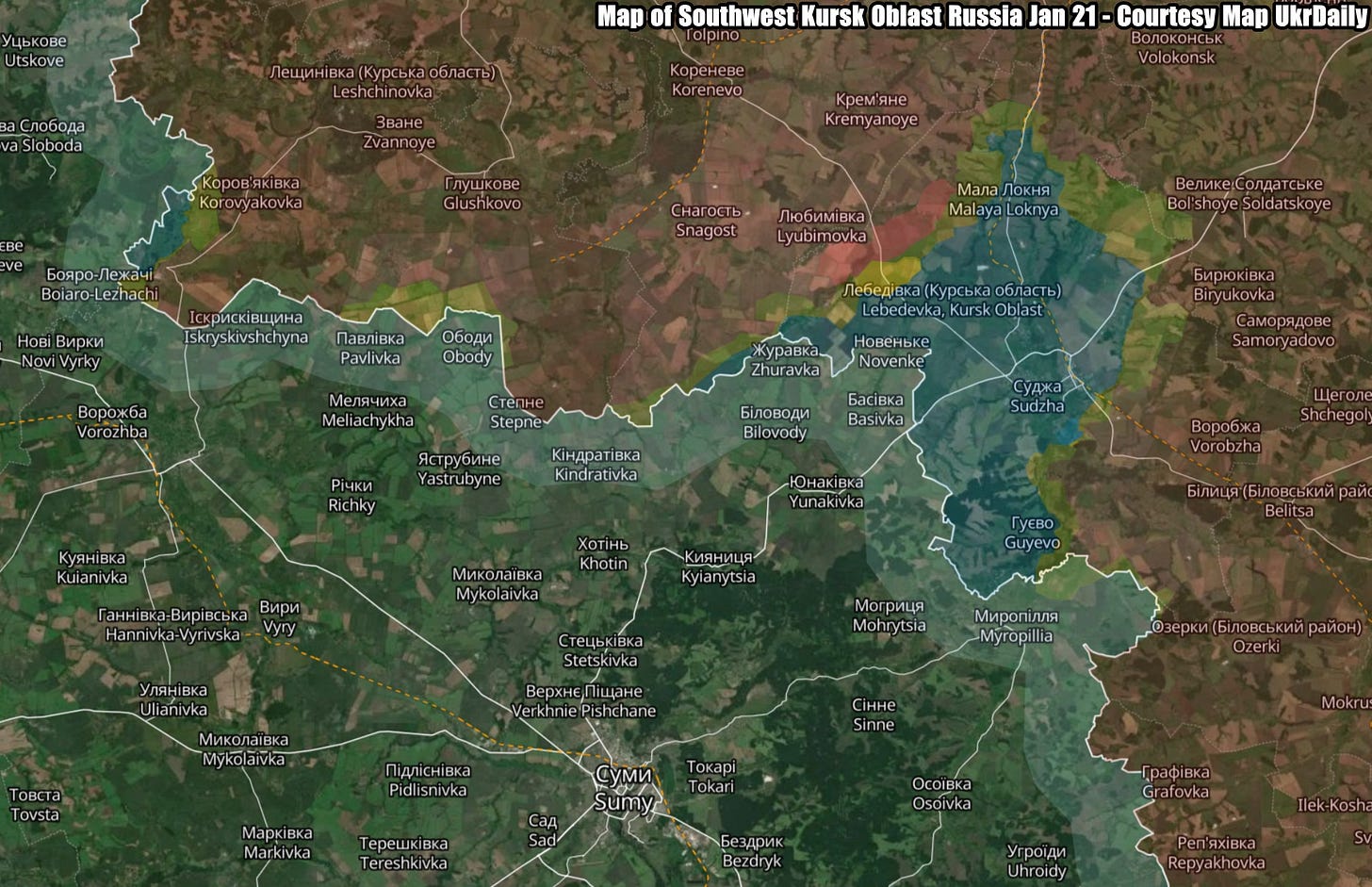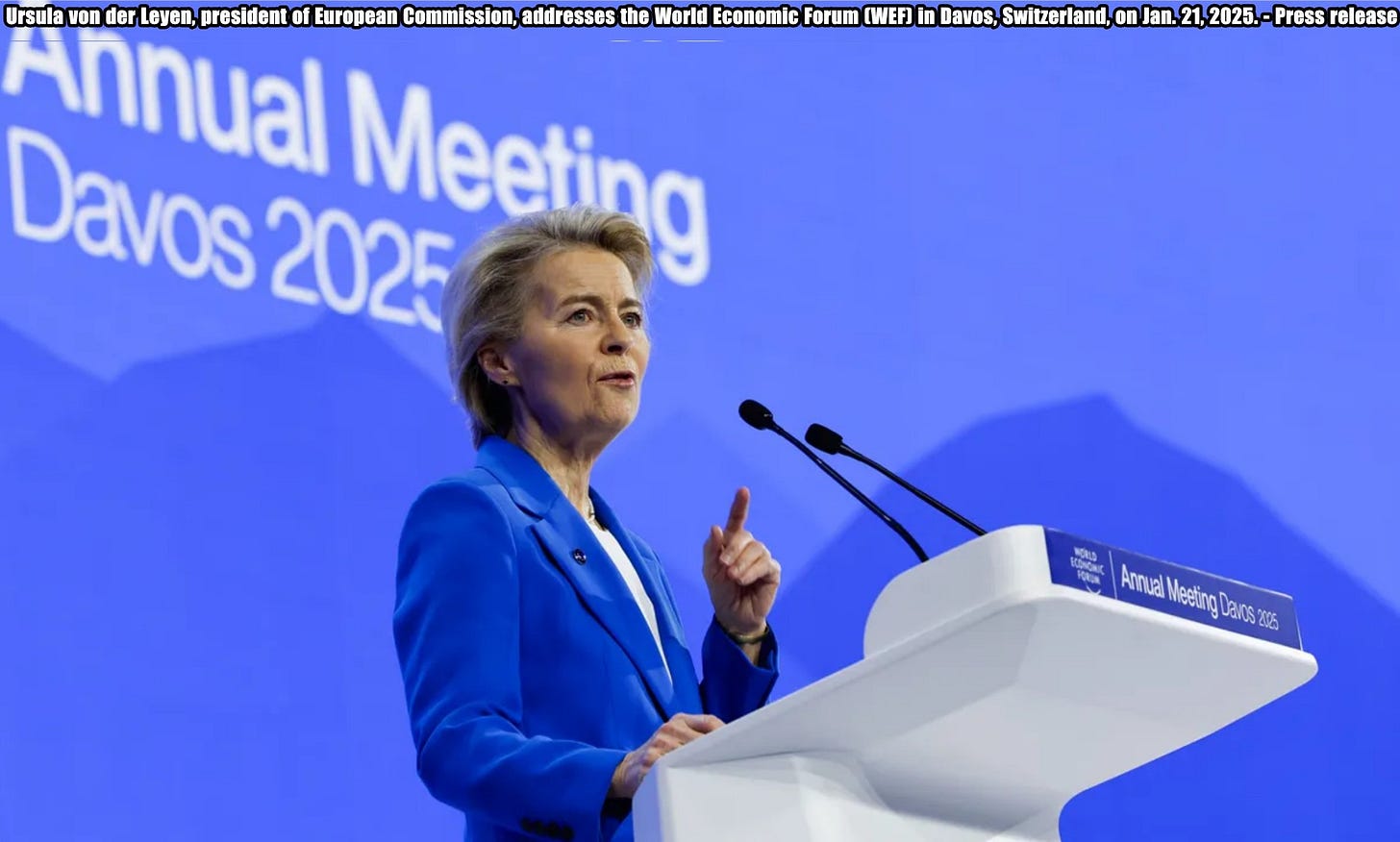Slava Ukraini! In early 2022 I began a Telegram channel aggregating news from a number of sources daily on the war in Ukraine. In June 2023 I began providing a daily draft for the Ukraine War Brief Podcast collecting news from over 70 sources daily, which formed the basis of the script. While the Podcast no longer exists I have continued to make this Brief available for my followers here on Substack for those who wish to keep up with the news from the war.
All the latest news on the Russo-Ukraine War 6 days per week
ALONG THE CONTACT LINE
GSAFU Morning Report
The General Staff of the Armed Forces of Ukraine in its Operational Information update at 08:00 on Jan 21 stated that day 1063 of the full-scale invasion of the Russian Federation against Ukraine had begun.
The situation on the line of combat remains tense in some sectors. Ukrainian defenders continue to actively counteract the Russian aggressor, causing them losses in personnel equipment and technology. Exhausting the enemy along the entire front line and continuing to disrupt the plans of Russian occupiers to advance deeper into the territory of Ukraine.
During the past day, 152 combat engagements took place.
Over the past 24 hours, the enemy carried out 3 missile strikes, 72 air strikes, used 2,653 drones and approximately 5,000 artillery strikes across the positions of Ukrainian forces and civilians.
Air Force Daily Report
72 ENEMY UAVS SHOT DOWN, 59 DRONES FAILED TO REACH THEIR TARGETS (LOCATIONALLY LOST)
➖➖➖➖➖➖➖➖➖
On the night of January 21, 2025 (from 20:00 on January 20), the enemy attacked with the 131st Shahed strike UAV and simulator drones of various types from the directions: Millerovo, Orel, Primorsko-Akhtarsk - Russia, and also used 4 Iskander-M ballistic missiles from the Voronezh region.
The air attack was repelled by aviation, anti-aircraft missile troops, electronic warfare units, and mobile fire groups of the Air Force and Defense Forces of Ukraine.
As of 09:00, it was confirmed that 72 Shahed attack UAVs and drones of other types were shot down in Poltava, Sumy, Kharkiv, Cherkasy, Chernihiv, Kyiv, Zhytomyr, Khmelnytskyi, Vinnytsia, Kirovohrad, Dnipropetrovsk, Donetsk, Mykolaiv, Odesa, Zaporizhia and Rivne regions.
59 enemy drone simulators were lost in location (without negative consequences).
In Poltava and Cherkasy regions, institutions, outbuildings, and private homes were damaged. Special services are eliminating the consequences, with no victims or injuries reported.
Combat Operations in the Russian Federation
The Institute for the Study of War (ISW), a US based think tank, in its Jan 20 Russian Offensive Campaign Assessment reported that Russian forces continued offensive operations in the Ukrainian salient in Kursk Oblast on Jan 20 but did not make any confirmed advances. Russian milbloggers claimed that Russian forces attacked northwest of Sudzha near Nikolskiy and towards Viktorovka from Novoivanovka and south of Sudzha near Kurilovka.[22] A Russian milblogger claimed that Ukrainian forces counterattacked north of Sudzha near Staraya Sorochina and Novaya Sorochina and south of Sudzha in Makhnovka. Elements of the Russian 56th Airborne (VDV) Regiment (7th VDV Division), 83rd VDV Brigade, 40th Naval Infantry Brigade (Pacific Fleet, Eastern Military District [EMD]), and the "Kashtan" unit of Chechen Akhmat Spetsnaz reportedly continue operating in Kursk Oblast.
The Khortytsia operational-strategic group
(Responsible for the northeastern part of Ukraine. )
Toretsk Sector: Russian forces recently advanced in Toretsk amid continued fighting in the area on January 20. Geolocated footage published on January 18 and 20 indicates that Russian forces recently advanced within southern and northern Toretsk, respectively.
The Tavria operational-strategic group
(Responsible for the central-eastern and southeastern part of Ukraine.)
Pokrovsk Sector : Russian forces recently advanced in the Pokrovsk direction amid continued offensive operations in the area on January 20. Geolocated footage published on January 19 indicates that Russian forces advanced at the Pokrovske Mine no. 2 north of Kotlyne (west of Pokrovsk) and in southern Kotlyne.
Kurakhove Sector: Russian forces recently advanced in the Kurakhove direction amid continued offensive operations in the area on January 20. Geolocated footage published on January 19 and 20 indicates that Russian forces recently advanced south of Petropavlivka (northwest of Kurakhove) and southeast of Kostyantynopil (west of Kurakhove).
The Odesa operational-strategic group
(Responsible for Kherson, Qırım, (also known as Crimea) and the Black Sea.)
There have been no major changes to the combat environment since our last report.
TEMPORARILY OCCUPIED TERRITORIES
Nothing major to report.
THE HOME FRONT
Ukraine’s police shows faces of Russian soldiers who murdered civilians in Bucha
Ukraine’s National Police has identified all 12 Russian paratroopers responsible for killing 16 civilians at a key intersection in Bucha during the Russian occupation in March 2022. Euromaidan Press reported
As of 31 March 2024, Ukrainian police reported that following Bucha’s liberation from Russian forces, 422 murdered civilians were found in the city, with a total of 1,190 bodies discovered in the Bucha district. These numbers are not final, as 514 residents of Kyiv Oblast remain missing, and 180 bodies are still unidentified.
Bodies discovered after the liberation showed evidence of torture. Many were found in mass graves or lying in streets with their hands bound and shot at close range.
The identified victims, aged 14 to 69, were shot at the intersection of Vokzalna and Yablunska streets in Bucha between 5-9 March 2022, while attempting to evacuate, reach family members, or search for food, the National Police reports.
Among those killed were several civilians whose images later gained international attention, including a woman with red nail polish and a female volunteer who burned alive in a minibus, becoming a symbol of Russian atrocities.
The commander of the unit, Artyom Tareyev, from the 234th Airborne Assault Regiment based in Pskov has been issued a notice of suspicion for ordering troops to “open fire on anyone who came into their field of view” at the intersection.
The commander personally supervised the operation, directing the establishment of firing positions and organizing troop rotations at the location. If convicted, the commander faces possible life imprisonment.
The National Police indicates it is working with the International Criminal Court, providing evidence that could be used in future proceedings against Russia’s military and political leadership.
RUSSIAN WORLD
Ukraine targets Smolensk aviation plant, trigger oil depot fire in Voronezh Oblast.
There were widespread Ukrainian drone attacks across several of Russia’s regions overnight on Jan 21, with multiple strategic facilities targeted and residents evacuated from some areas. Euromaidan Press reports citing local authorities.
Russia’s Defense Ministry claimed that air defense systems intercepted 55 Ukrainian drones over six regions. The ministry stated that 22 drones were shot down over Bryansk Oblast, 12 over Rostov Oblast, ten over Smolensk Oblast, six over Voronezh Oblast, four over Saratov Oblast, and one over Kursk Oblast.
In Smolensk Oblast, local residents reported hearing more than 10 powerful explosions, RFE/RL Russian reports. The Smolensk Aviation Plant, which produces Kh-55 and Kh-59 missiles used against Ukraine, was reportedly among the targets. According to the Russian news Telegram channel Astra, a fire broke out at the aviation plant following the drone attack. Citing its sources, Astra says the drone attack on the roof of a workshop at the Smolensk Aviation Plant overnight caused a fire but did not halt operations.
Smolensk Oblast Governor Vasiliy Anokhin claimed that drone debris caused roof fires on several buildings and damaged windows of residential buildings. While confirming the interception of Ukrainian drones, Anokhin dismissed videos showing “drone raids on facilities and residential buildings” as “fake information” intended to “create panic and destabilize the situation.”
In Voronezh Oblast, Governor Alexander Gusev reported yet another fire at an oil depot in the Liski district following a drone strike on Monday evening. According to the ASTRA Telegram channel, the facility belongs to Rosneft and had previously been targeted by Ukrainian drones on 16 January, with the resulting fire taking several days to extinguish.
The GSAFU confirmed the attacks:
For the second time this week, drones from Ukraine’s Special Operations Forces hit the “Liskinskaya” oil depot in Russia’s Voronezh Oblast overnight on 21 January, igniting fuel storage tanks supplying Russian troops, the military said. The facility is owned by the state corporation Rosneft.
In Smolensk Oblast, drones and Special Operations Forces struck the infrastructure of the Smolensk Aviation Plant, where combat aircraft are manufactured and modernized, resulting in explosions on the premises, according to the report.
In the temporarily occupied city of Volnovakha, Donetsk Oblast, strikes targeted the command post of Russia’s 29th Combined Arms Army, with explosions and smoke reported in the area, the General Staff added.
INTERNATIONAL NEWS
EU plans to eliminate Russian fossil fuels, aims to end gas imports.
The European Commission is developing a strategy to eliminate Russian fossil fuels from the European Union's energy market. However, gas deliveries from Russia to Europe persist despite the EU's efforts, and Brussels is determined to halt this, The Kyiv Independent reported citing Anna-Kaisa Itkonen, the EU’s spokesperson for energy and housing.
Speaking at a press briefing in Brussels on Jan. 20, Itkonen noted that work on a comprehensive roadmap to fully phase out Russian fossil fuels is ongoing. "This initiative was announced as a priority for the Energy Commission to deliver within its first 100 days, so we still have a little time before the deadline," she said, according to Interfax news agency.
Itkonen highlighted that the EU has already made substantial progress in reducing its dependence on Russian energy. "We have significantly reduced imports of Russian gas, eliminated all coal imports from Russia, and cut most oil imports," she explained.
Despite these achievements, Russian gas continues to be present on the EU market, which remains a concern. "This is an issue we aim to address in the roadmap that will be unveiled in the coming weeks," Itkonen added.
Putin and Xi Tout Growing Partnership During Video Call
Russian President Vladimir Putin and Chinese President Xi Jinping praised their growing partnership during a video call on Tuesday, hours after Donald Trump was inaugurated as the 47th president of the United States. The Moscow Times reports.
Trump, who has pledged a tougher stance on Washington's adversaries, has threatened heavy tariffs on China and warned Russia of "big trouble" if it refuses to bring an end to its war against Ukraine.
Putin, addressing Xi, said Russia and China were strengthening ties "on the basis of friendship, mutual trust and support" despite external pressures.
"Russia and China's joint efforts play an important stabilizing role in international affairs," the Kremlin leader said.
Xi, for his part, expressed hope to elevate ties with Moscow to "new heights" this year, according to Chinese state broadcaster CCTV.
"Both sides should continue to deepen strategic coordination, resolutely support each other and safeguard the legitimate interests of both countries," CCTV quoted Xi as saying. He also called for expanding bilateral relations and advancing "practical cooperation."
Moscow and Beijing have bolstered military and trade ties since Russia launched its full-scale invasion of Ukraine, prompting alarm in the United States, which views both nations as major threats to global stability.
China has maintained a stance of neutrality regarding the conflict but remains a close political and economic ally of Moscow, refraining from condemning Russia's actions.
The Chinese and Russian leaders emphasized their personal rapport during Tuesday's call, with Xi referring to Putin as his "best friend" and Putin describing Xi as a "reliable partner."
Zelenskyy arrives in Davos for the World Economic Forum
President of Ukraine Volodymyr Zelenskyy has arrived in Davos, Switzerland, to participate in the World Economic Forum, Ukrainska Pravda reports citing Zelenskyy’s press service.
He will deliver a special address today at the forum.
He is also expected to hold bilateral talks with country leaders, meetings with big businesses and other events.
Representatives from more than 130 countries, including more than 60 heads of state and government and more than 1,600 business representatives, are expected to attend a meeting in Davos.
US President Donald Trump will not be physically present at the event but will join it online and deliver a speech on Thursday, 23 January.
Zelenskyy - Russia did not have enough strength to push us out of Kursk. 4,000 DPRK members have already been eliminated.
Ukrainian president Volodymyr Zelenskyy, during a speech at the World Economic Forum stated that Russia cannot force the Ukrainian military out of the Kursk region.
"We are still in the Kursk region, and our military is there. Russian forces were not enough to push us out. Today, there are more than 60,000 Russian troops there (in this area), in addition to 12,000 North Koreans, 4,000 of whom were killed. It was Putin's strategy to involve another country...," Zelenskyy said.
He also believes that Iran has already been drawn into the war after Russia began striking Ukraine with Iranian-made weapons.
"I am very grateful to the Armed Forces of Ukraine for drawing back the attack from the East in the Kursk direction. Russia wanted to capture Kharkiv," Zelenskyy emphasized, adding that the enemy also planned to occupy Sumy.
EU has reduced Russian gas imports by 75%, von der Leyen says.
The EU has reduced Russian gas imports by 75%, while only 3% of its oil is imported from Russia, European Commission President Ursula von der Leyen said at the World Economic Forum in Davos on Jan. 21. The Kyiv Independent reports.
The share of Russian coal in Europe’s imports also went from 50% before Russia’s full-scale invasion to zero by 2025, she said.
“Our gas imports from Russia went down by roughly 75% and now we import from Russia only 3% of our oil and no coal at all anymore," von der Leyen said.
Europe began to wean itself off Russian energy commodities after Moscow’s full-scale invasion of Ukraine while Gazprom steadily reduced flows to the EU to pressure Ukraine’s allies.
"This (Russian) energy appeared cheap, but it exposed us to blackmail. So when (Russian President Vladimir) Putin's tanks rolled into Ukraine, Putin cut us off his gas supplies, and in return, we substantially reduced our dependency on Russian fossil fuels in record time," she added.
Kyiv's decision not to prolong a gas transit deal with Gazprom past December 2024 ended the supply of Russian pipeline gas to the EU. European countries continue buying Russian liquified natural gas, purchasing record amounts in 2024.
Moscow and Kyiv signed an agreement in 2019 to transit 40 billion cubic meters of Russian gas annually through Ukraine to buyers in the EU. Gazprom raked in an estimated $5–$6.5 billion annually from the deal.
Thousands of participants, including political leaders and CEOs, have gathered for the annual World Economic Forum in Davos this week. President Volodymyr Zelensky is also attending the forum and is expected to meet top political and business officials.
MILITARY & TECH
Russia has created an artillery hybrid, potentially driven by entirely rational motives.
According to The Military Balance 2024, at the beginning of last year, the Russian army had 550 towed Giatsint-B howitzers and only 250 Msta-B howitzers in active service. For comparison, data from 2022 in the same reference book indicates that the Russian army, either in active service or storage, had significantly more Giatsint-B howitzers than Msta-B —1,100 units compared to 750 units, respectively. Defense Express reports.
These figures not only illustrate the depletion rate of the Russian army's towed artillery during the war against Ukraine but also hint at the logic behind their decision to create an artillery based on the Giatsint-B.
To elaborate, it is worth noting that, in late December 2024, reports emerged about the appearance of a new russian wheeled self-propelled artillery system. This system integrates the artillery component of the Giatsint-B with the Voshchina chassis from the modern 2S43 Malva. Initially, identifying the design features of this improvised artillery system was challenging due to the presence of protective grilles and "barbecue" armor.
Recently, however, a photo of this system, free from its "barbecue" armor and additional attachments, has surfaced in open sources, offering some insight into this piece of enemy artillery.
Despite this, the specific designation of the self-propelled artillery system remains unknown, as does its potential production scale. It is unclear whether this is a one-off prototype or if Russia plans to commence mass production of such systems equipped with the Giatsint-B artillery component.
This Frankenstein design may also reflect an attempt by the Russians to rationalize their 2S43 Malva wheeled self-propelled artillery project. The existence of the Malva was first disclosed in 2019, well before Russia's full-scale invasion of Ukraine.
It is likely that the designers of the 2S43 Malva, who initially planned to use the Msta-B artillery component, assumed that a sufficient number of these howitzers could be sourced from storage. As of early 2022, the Russians reportedly had approximately 600 Msta-B howitzers in reserve, making this assumption reasonable at the time.
However, as the war progressed and the Russians began withdrawing 152-mm towed howitzers from storage, relying on the Msta-B as a component for the new wheeled self-propelled artillery system became less practical. Against this backdrop, the idea of "upgrading" the 2S43 Malva project to incorporate the Giatsint-B artillery component may have emerged.
Mystery drone strikes target Russia overnight.
Overnight unidentifiable unmanned aircraft strikes targeted various locations across Russia, with the Russian Ministry of Defense reporting that 55 drones were intercepted over multiple regions.
Despite these claims, social media posts and videos suggest that some drones successfully hit their intended targets, including the Smolensk Aviation Plant.
The Smolensk Aviation Plant appears to have been one of the primary targets of the attacks. Footage shared on social media shows drones flying at extremely low altitudes, sometimes as low as 20 meters, to evade detection and countermeasures. One of the drones was captured on video as it struck its target.
Preliminary analysis suggests the use of a previously unidentified long-range kamikaze drone, tentatively identified as the Chaklun-V. The drone is believed to have a range of 700 kilometers and a warhead capacity of 20 kilograms, making it a potent weapon for deep strikes.
That’s it for today’s Brief folks if you would like to keep up with events in Ukraine daily please consider subscribing, it’s free!


